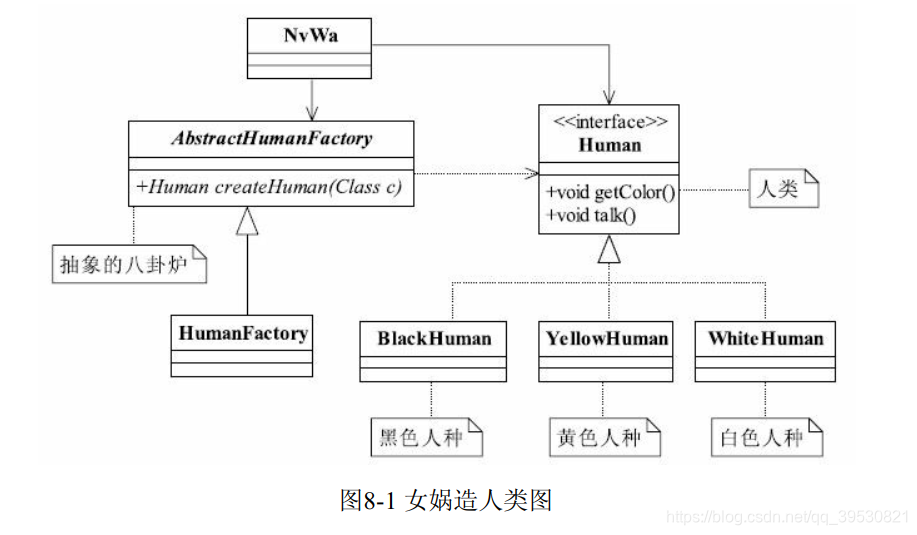3-工厂模式 - 创建型模式
本文共 2101 字,大约阅读时间需要 7 分钟。
文章目录
1. 例子

public interface Human { void getColor(); void talk();} 各个人种:
public class YellowHuman implements Human { @Override public void getColor() { System.out.println("YellowHuman is yellow"); } @Override public void talk() { System.out.println("YellowHuman talk"); }}public class WhiteHuman implements Human { @Override public void getColor() { System.out.println("WhiteHuman is white"); } @Override public void talk() { System.out.println("WhiteHuman talk"); }}public class BlackHuman implements Human { @Override public void getColor() { System.out.println("BlackHuman is black"); } @Override public void talk() { System.out.println("BlackHuman talk"); }} 工厂:
public abstract class AbstractHumanFactory { public abstract T createHuman(Class c);}public class HumanFactory extends AbstractHumanFactory { @Override public T createHuman(Class c) { T instance = null; try { instance = (T) Class.forName(c.getName()).newInstance(); } catch (Exception e) { System.out.println("创建人类失败"); } return instance; }} 女娲造人:
public class NvWa { public static void main(String[] args) { HumanFactory humanFactory = new HumanFactory(); YellowHuman yellowHuman = humanFactory.createHuman(YellowHuman.class); WhiteHuman whiteHuman = humanFactory.createHuman(WhiteHuman.class); BlackHuman blackHuman = humanFactory.createHuman(BlackHuman.class); yellowHuman.getColor(); yellowHuman.talk(); whiteHuman.getColor(); whiteHuman.talk(); blackHuman.getColor(); blackHuman.talk(); }} 2. 定义和特点
定义一个创建对象的接口,让子类决定实例化哪个类。工厂方法使得类的实例化延迟到子类。
有以下特点:
- 良好的封装性,代码结构清晰,调用者只需知道产品的类名或其他字符串就可以创建产品对象,不需要了解产品的创建过程;
- 扩展性优秀,可以扩展产品,像上面就可以增加棕色人种;
符合以下三个原则;
- 迪米特原则,工厂模式不需要对产品了解;
- 依赖倒置原则,只依赖产品的接口或者抽象类;
- 里氏替换原则,创建产品的方法参数是接口或抽象类。
3. 工厂模式的扩展
3.1 简单工厂模式
也叫静态工厂模式。

3.2 升级为多个工厂模式

转载地址:http://xphwz.baihongyu.com/
你可能感兴趣的文章
New Relic——手机应用app开发达人的福利立即就到啦!
查看>>
new 一个button 然后dispose,最后这个button是null吗???
查看>>
next项目部署到服务器pm2进程守护
查看>>
nexus上传jar
查看>>
Nexus指南中的更新强调集成和透明度的重要性
查看>>
Nexus指南已经发布
查看>>
NFinal学习笔记 02—NFinalBuild
查看>>
NFS
查看>>
NFS Server及Client配置与挂载详解
查看>>
NFS 服务配置篇
查看>>
NFS共享文件系统搭建
查看>>
nfs复习
查看>>
NFS安装配置
查看>>
NFS服务器配置-服务启动与停止
查看>>
NFS的安装以及windows/linux挂载linux网络文件系统NFS
查看>>
NFS的常用挂载参数
查看>>
NFS网络文件系统
查看>>
NFS远程目录挂载
查看>>
nft文件传输_利用remoting实现文件传输-.NET教程,远程及网络应用
查看>>
NFV商用可行新华三vBRAS方案实践验证
查看>>